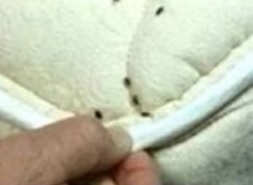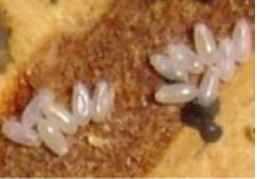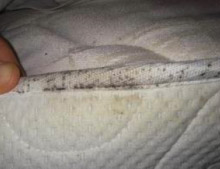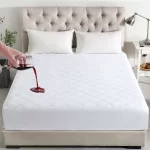Once you have found you have a bed bug problem the best thing to do is act fast to try and prevent an infestation. If an infestation occurs bed bugs and their eggs can sometimes be a very hard and nerve-racking thing to eradicate.
Where to look for bed bugs
One of the main areas you will get bed bugs are in the bedroom, so let’s start with some things you can do yourself before calling a pest control company.
First, begin looking around your mattress, bedding and bed base. With large infestations of bed bugs, there are often little brown or near-black dots on the mattress seams, on bedding or on the bed base. They can also be found hiding in cracks and crevices, cabinets and drawers, picture frames, drapes and curtains, sofas and other furniture. With the presence of many bed bugs, they become more visible to the human eye. So spotting an actual bed bug is likely, and it will looks like a small, brown, flat, wingless parasite – similar to a tick or small cockroach. Bed Bugs are quite efficient at quickly processing their meals and will litter the area on their way back with blood drips and their droppings. To the naked eye, these droppings or blood spots will look as if someone dusted the area with black pepper.

The best way to look for bed bugs is to take a flashlight and start your inspection. Thoroughly inspect your mattress and bed base for blood spots bed bug faecal spots and eggs. Look along top and bottom seams of the mattress and base, turn base over and check underneath. If bed bugs or eggs are found use you’re vacuum to suck them up and empty the contents in a plastic bag seal and throw away.
Check along edges of carpet and skirting boards, around door and window frames, if there is any cracks or holes the tiny bed bugs can hide in there. Look behind pictures on the wall, tops and bottoms of curtains under furniture, word ropes, in and behind books.



Checklist
Check the following areas for bed bug signs, e.g. clusters of small black spots, blood stains on bedding bed bug eggs, bed bug casings.
- Mattresses, including around any seams, top and bottom
- Bed heads, material or timber – if there is a crack they can hide there
- Bed base and under any material covering it
- Around legs and casters of the bed base
- Bed side tables top and bottom, turn furniture over and check base
- Telephones and electrical sockets
- Skirting boards
- Cracks around architraves
- Carpet edges and under any loose carpet
- Floor boards
- Behind pictures/mirrors
- Books, between pages and bindings
- Tops and bottoms of curtains
Act fast – prevent an infestation
Wash all bedding in hot water about (120°F minimum) and in the dryer on warm to hot for 15-20 minutes.
Remove all clutter from room as they live and hide in any nook or cranny. Check for signs of bed bugs if found, place in plastic bags and throw away if possible.
If bed bugs are found you should encase your mattress, bed base and pillows ASAP with a quality brand bed bug encasement. The encasements will prevent bed bug from entering or escaping. Even if there are bed bugs you can fit the encasements and no need to throw away your expensive beds. Don’t bother spraying household pest sprays or ‘bug bombs’ they are ineffective against bed bugs.
Call in the experts
Bed bugs are highly resistant to pesticides and a lot of chemicals, making their elimination difficult. Bed bugs are also prolific breeders, as females can lay eggs up to five times a day for her entire life. Bed bugs can also live up to a year without a meal. There are many different ways of treatment being tested now to try and control infestations of bed bugs. The use of steam is very effective as it will kill the bed bugs as well as their eggs, which is good as the use of chemicals will not kill the eggs as it cannot penetrate the bed bug casing. Diatomaceous earth is also being used as well as many types of traps, glues, tapes and now some pest controllers are using trained sniffer dogs to track down bed bugs. Special designed bed bug encasements are a solution to stop infestation in your mattresses, bed bases and pillows. Early bed bug protection is critical to the prevention and management of these parasites.
Unfortunately, if you are still having trouble with bed bugs you will have to call on a professional exterminator. Make sure he has dealt with bed bugs before, ask them how many times he is coming back for treatment, will they guarantee their work. They should come back a least twice, with 2 weeks break between treatments. Chemicals will not kill the bed bug eggs. If there are eggs on the first treatment they will have hatched by the 2nd treatment. While professional help can be expensive, most exterminators do a thorough job.
Cover and Protect The Bed Protection Specialists. Sydney, Australia.
For sales or further information please visit our website or call Cover and Protect on 02 931 66654




